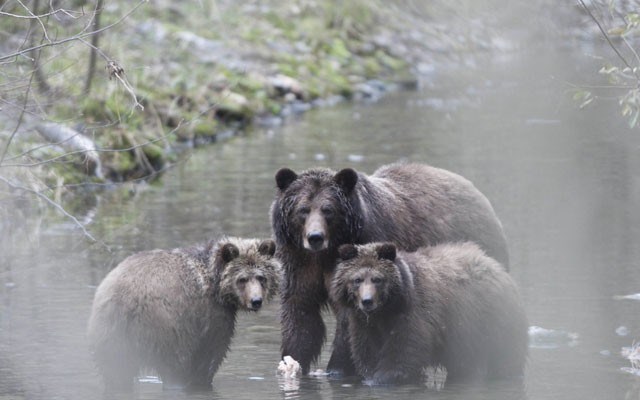Majestic Residents A grizzly bear photographed here with two 10-month old cubs near Squamish in 2015 has returned this fall to a much higher chum salmon run. The sow will den-up in late November and likely push the two-year old cubs away next spring. Grizzly sightings are up in 2016 (See story on page 26).
With grizzly sightings up in the Sea to Sky this year, the Conservation Officer Service (COS) is reminding the public of the best ways to stay safe in bear country.
There are thought to be roughly 59 grizzlies between Howe Sound in Squamish and Pemberton Meadows. So far this year, the COS has received a dozen reported grizzly sightings compared to six in all of 2015.
Conservation officer Tim Schumacher believes the popularity of backcountry recreation could be a factor in the higher number of sightings in 2016.
"I just think with how many more people we have out recreating in the backcountry, we are going to get more conflicts and sightings so that would also contribute to the higher number of sightings," he noted, adding that it's still highly unlikely to encounter a grizzly in this part of B.C. compared to a black bear.
Johnny Mikes of the Coast to Cascades Grizzly Bear Initiative said the corridor's grizzly numbers are also "starting to rebound a bit" after years of decline, but that development still poses the biggest threat to bear habitat in the region.
"There are serious challenges in terms of grizzly bear connectivity. We need to make the landscape more permeable and safer for bears to move through," he said. "In some cases that means working with communities to think about how many roads are open that would disturb bears in certain key locations, and in other places it's more about making sure we don't overdevelop places that are working not too badly for connectivity right now."
One grizzly population that isn't faring as well is in the Stein-Nahatlatch east of Garibaldi. One of five threatened grizzly population units in southwestern B.C., Mikes said it is the most genetically isolated mainland grizzly population in North America.
"The genetic data we have basically shows (all the bears) are descended from one female," added Mikes. "For bears to get across Highway 99, through Whistler, the mountains and ruggedness of Garibaldi Park, adds to the Stein-Nahatlach's challenges. The connectivity challenges are very real."
Like black bears, the best strategy to avoid conflict is to "make yourself look big" and "make lots of noise" if a grizzly charges you, Schumacher said. Grizzlies are less easily frightened then black bears and more likely to stand their ground.
"Encountering a grizzly, you would need to be much more cautious. We're really used to black bears and I think we have a rather cavalier attitude around them," explained Sylvia Dolson, executive director of the Whistler Get Bear Smart Society. "If you were to come across a mother grizzly bear and her cubs, we should remember that 76 per cent of attacks involve a mother and cubs. Really, you want to be non-threatening."
Schumacher also recommended bear spray as the "No. 1 tool" for dealing with a potential bear conflict.
"It's actually more effective than a firearm. Bear spray has a wide spray and there's never been a human fatality when bear spray has been deployed, and that's not the case with firearms," noted Schumacher.
For more information on bear safety and preventing conflicts, visit www.bearsmart.com.




